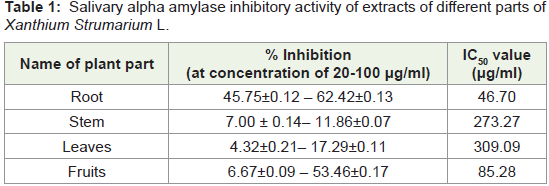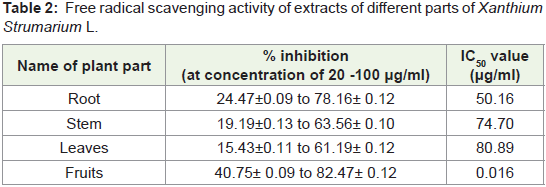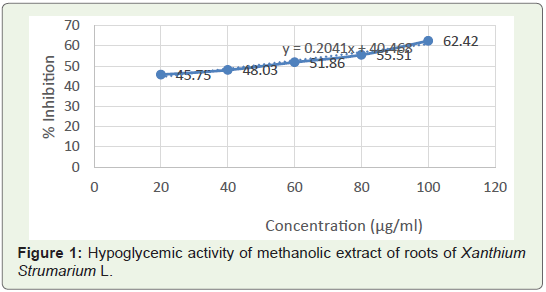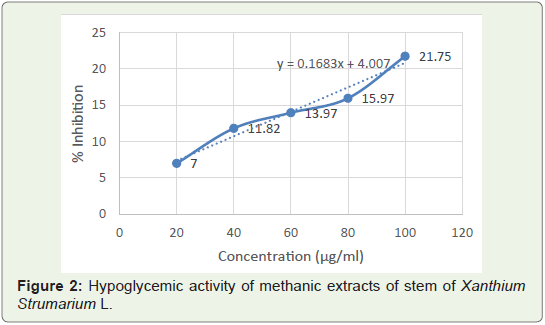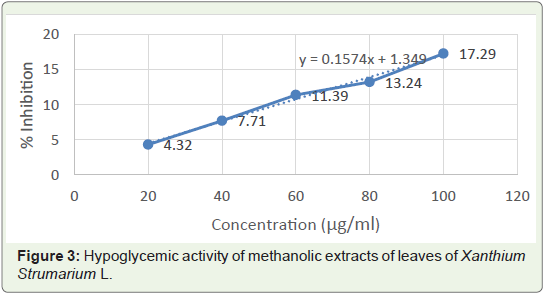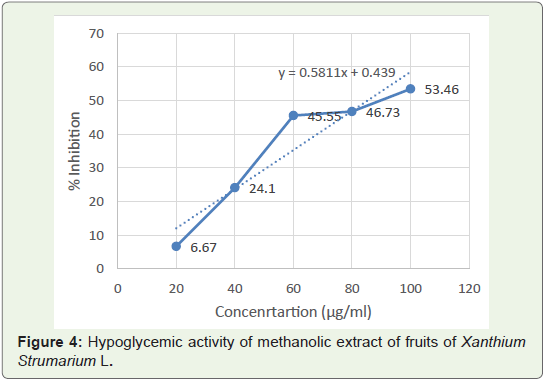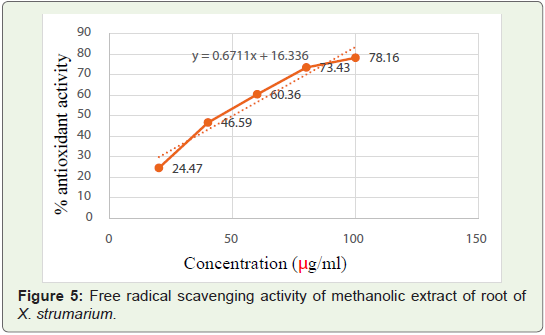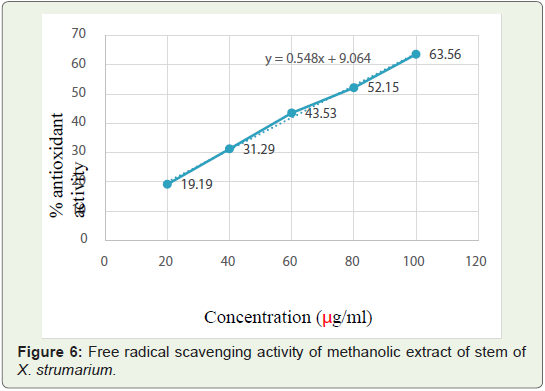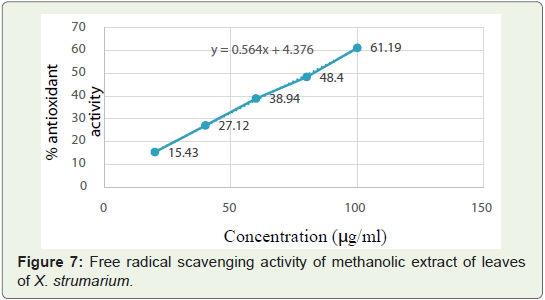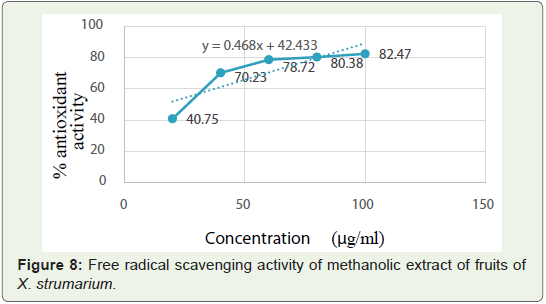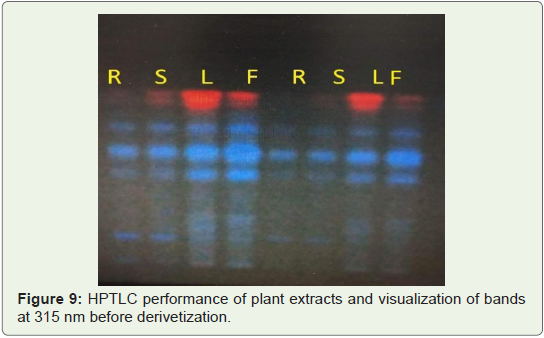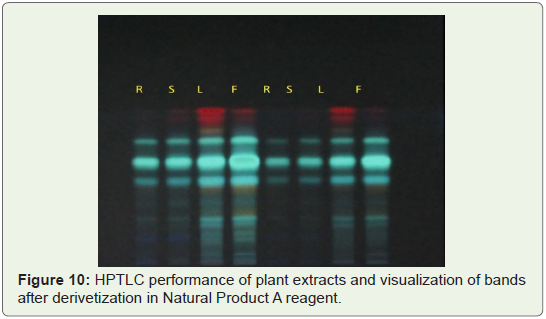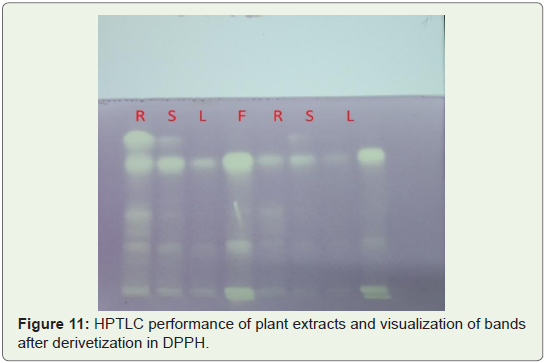Research Article
In Vitro Evaluation of Antioxidant and Hypoglycemic Potential of Extracts from Different Parts of Xanthium Strumarium L
Chitra Jain*, Vijaivergiya R and Khatana S
Department of Botany, University of Rajasthan, India
*Corresponding author: Chitra Jain, Department of Botany, University of Rajasthan, Jaipur- 302004, Rajasthan,
India; Email: drchitrajainbiochemistry@gmail.com
Copyright: © Jain C, et al. 2021. This is an open access article distributed under the Creative Commons Attribution License, which
permits unrestricted use, distribution, and reproduction in any medium, provided the original work is properly cited.
Article Information: Submission: 06/04/2021; Accepted: 05/05/2021; Published: 08/05/2021
Abstract
Introduction: Indian medicinal plants used in the Ayurveda traditional system to treat diabetes and to scavenge free radicals are a valuable source
of novel anti-diabetic agents. Alpha amylase inhibitors offer an effective strategy to lower the level of postprandial hyperglycemia via control of starch
breakdown. Plant extracts also possesses free radical scavengers which can be used to treat various diseases like cancer. Extracts of Xanthium Strumarium
L. have been considered as hypoglycemic and antioxidant agents.
Materials and Methods: In this study, we evaluated antioxidant potential and hypoglycemic potential of methanolic extracts of root, stem, leaves and
fruits of the plant by DPPH method and DNSA assay respectively.
Results: Results showed that all plant parts showed very good antioxidant and hypoglycemic activities with low IC50 values.
Discussion: results of present study showed that maximum salivary alpha amylase inhibitory activity was shown by methanolic extract of root with
minimum IC50 value i.e.46.70 μg/ml and maximum free radical scavenging activity was shown by methanolic extract of fruits with minimum IC50 value i.e.
0.016 μg/ml. Root extract also show good antioxidant potential.
Conclusion: The results of this study direct researchers to evaluate the therapeutic potential of secondary metabolites in the management of post
prandial hyperglycemia and type II diabetes mellitus either alone or in combinatorial therapy.
Keywords
Alpha amylase inhibitors; Postprandial hyperglycemia; Free radical scavenging activity; DPPH assay; DNSA method etc
Introduction
Nature has been a source of medicinal agents for many years.
Majority of the traditional medicines used in healthcare are obtained
from plants [1]. In spite of several advancements in the field of
synthetic drug chemistry and antibiotics, plants continue to be one of
the major raw materials for drug streating various human ailments.
Clinical and pharmaceutical investigations have in fact elevated the
status of medicinal plants by identifying the role of active principles
present in them and elaborating on their mode of action in human
and animal systems [2].
One important therapeutic approach for treating diabetes is by
decreasing the post prandial increase in blood glucose level. Alpha
amylase inhibitors play major role in the management of post prandial
hyperglycemia. It inhibits the action of alpha amylase enzyme leading
to a reduction in starch hydrolysis to maltose and consequentially
lower post prandial hyperglycemia [3]. Various medications are available for the treatment of Type II diabetes such as bigunides,
sulfonylureas, thiazolidinedione etc. But they have also exhibited a
number of undesired side effects associated with their uses and thus
suggesting other effective alternatives. Medicinal plants have been an
exemplary source in the treatment of various diseases including DM
particularly in developing countries like India, because of high cost
and poor availability of current therapies [4].
Oxidative stress is an important risk factor in the pathogens of
numerous chronic diseases. Free radicles and other reactive oxygen
species are recognized as agents involved in the pathogenesis
of sicknesses such as asthma, inflammatory arthropathies,
diabetes, Parkinson’s and Alzheimer’s diseases, cancers as well as
atherosclerosis. ROS are also said to be responsible for human aging
[5].
An antioxidant can be broadly defined as any substance that
delays or inhibits oxidative damage to a target molecule. The main
characteristic of an antioxidant is its ability to trap free radicals.
Antioxidant compounds like phenolic acids, polyphenols and
flavonoids scavenge free radicals such as peroxide, hydro peroxide or
lipid peroxides and thus inhibit the oxidation mechanisms that lead to
degenerative diseases. Herbal plants considered as good antioxidant
since ancient times [5].
Xanthium Strumarium L. belongs to family Asteraceae, commonly
known as cocklebur, is annual herb commonly found in India, North
America, Brazil, China and Malaysia. Various plant parts have been
traditionally used for treatment of various diseases like eczema, fever,
salivation, congestive heart diseases, nephritis, toxemia of pregnancy,
hypertension, premenstrual tension etc.
In this study we tried to find out antioxidant and hypoglycemic
potential of methanolic extracts of roots, stem, leaves and fruits of
Xanthium Strumarium L. We also confirmed antioxidant potential of
the extracts due to presence of flavonoids in the plant parts by using
High Performance Thin Layer Chromatography (HPTLC).
Materials and Methods
Collection of Plant material:
Carefully inspected healthy plant parts (root, stem, leaves and
fruits) of Xanthium Strumarium L. were collected from Jaipur in
the month of September-October 2017. The selected plants were
botanically identified and authenticated. The plant parts were washed
and dried at room temperature (27-30oC) for 15-20 days maintaining
hygienic conditions. After complete drying, plant materials were
grounded to form powder using a domestic electric grinder and then
stored in brown bottles to conduct the experimental protocols.Preparation of extracts:
10 gram of each selected plant parts were dissolved in 100 ml
of methanol separately and kept in shaking incubator (40 RPM) at
room temperature for 24 hours. Then extracts were filtered by using
Whatmann’s filter paper No. 1 and then used for further experiments.Evaluation of hypoglycemic potential:
The inhibition assay was performed using the chromogenic
DNSA method [7]. The total assay mixture composed of 500 μl of
0.02 M sodium phosphate buffer (pH 6.9 containing 6 mM sodium chloride), 1ml of salivary amylase and 400 μl extracts at concentration
from 0.3-1.5 mgml-1(w/v) were incubated at 37°C for 10 min. After
pre-incubation, 580 μl of 1% (w/v) starch solution in the above
buffer was added to each tube and incubated at 37°C for 15 min. The
reaction was terminated with 1.0 ml DNSA reagent, placed in boiling
water bath for 5 min, cooled to room temperature, diluted and the
absorbance were measured at 540 nm. The control represented 100%
enzyme activity and did not contain any plant extract. To eliminate
the absorbance produced by plant extract, appropriate control
with the extract in the reaction mixture except for the enzyme was
included.The % inhibition of alpha amylase was calculated as follows:
Evaluation of antioxidant potential:
The antioxidant activity of plant extracts were determined by
DPPH (2,2-diphenyl-1-picrylhydrazyl) free radical scavenging assay
[8]. Experiments were initiated by preparing a 0.004% w/v solution of
DPPH and 1mg/ml solution of different plant extracts in methanol. 2
ml of the methanolic solution of DPPH was added to a sample solution
(0.1 ml). An equal amount of alcohol was added to the control. The
setup was left at dark in room temperature and the absorption was
monitored after 30 minutes at 515 nm.The percentage of free radical scavenging activity was calculated
from the following equation-
Statistical Data Analysis:
All experiments were performed in 3 different sets with each set
in triplicates. The data were expressed as mean ± SEM (standard error
of the mean). Statistical difference, ANOVA and linear regression
analysis were performed using Graph pad prism 5 statistical software.
The IC50 values were determined from plots of percent inhibition
versus log inhibitor concentration and calculated by logarithmic
regression analysis from the mean inhibitory values. The IC50 values
were defined as the concentration of the extract that showed 50%
inhibition.Evaluation of Antioxidant activity by HPTLC:
HPTLC was performed of all extracts by using standard mobile
phase and visualized plates at 315 nm. Plates were run in mobile
phase (ethyl acetate: acetic acid: formic acid: water). Then one plate
was derivetized by dipping it into natural product reagent A (NP
reagent A) which is specific for flavonoids. Another plate was dipped
into DPPH and kept in dark for 1 minute. Then both plates were
compared.Results
The results revealed that methanolic extracts (at concentration
of 20 μg/ml -100 μg/ml) of selected parts of plant exhibited different
degree of alpha amylase inhibitory activity and free radical scavenging
activity. Methanolic extract of roots of the plant showed 45.75±0.12
% to 62.42±0.13 % salivary alpha amylase inhibition with an IC50 value of 46.70 μg/ml and 24.47±0.09 to 78.16± 0.12 % free radical
scavenging activity with an IC50 value of 50.16 μg/ml.
Methanolic extract of stem of the plant showed 7.00 ± 0.14 % to
11.86±0.07 % salivary alpha amylase inhibition with an IC50 value
of 273.27 μg/ml and 19.19±0.13 % to 63.56± 0.10% free radical
scavenging activity with an IC50 value of 74.70 μg/ml.
Methanolic extract of leaves of the plants showed 4.32±0.21%
to 17.29±0.11 % inhibition of salivary alpha amylase with an IC50
value of 309.09 μg/ml and 15.43±0.11% to 61.19± 0.12 % free radical
scavenging activity with an IC50 value of 80.89 μg/ml.
Methanolic extract of fruits of the plant showed 6.67±0.09 %
to 53.46±0.17 % inhibition of salivary alpha amylase with an IC50
value 85.28 μg/ml and 40.75± 0.09 % to 82.47± 0.12 % free radical
scavenging activity with an IC50 value of 0.016 μg/ml.
Percent inhibition and IC50 values of different extracts are shown
in Table 1 and 2 and graphically represented in Figure 1-8.
Table 1: Salivary alpha amylase inhibitory activity of extracts of different parts of
Xanthium Strumarium L.
Results of HPTLC showed that flavonoids were seen as bluegreen
bands in fluorescence after dipping into NP reagent A and the
second plate which was dipped into DPPH, was turned into violet
color having yellow bands (at places where antioxidant compounds
were present). On comparisons of both plates it was conformed that
antioxidant potential of methanolic extracts of the plant was due to
presence of flavonoids as in the presence of DPPH, bands showing
flavonoids (compared with band in NP reagents) changed its color
from purple to yellow as shown in Figure 9-11.
Figure 9: HPTLC performance of plant extracts and visualization of bands
at 315 nm before derivetization.
Figure 10: HPTLC performance of plant extracts and visualization of bands
after derivetization in Natural Product A reagent.
Discussion
Drugs that reduce post prandial hyperglycemia by suppressing
hydrolysis of starch such as alpha amylase inhibitors have been found
useful in the control of diabetes mellitus [9]. Many herbal extracts
have been reported for their anti-diabetic activities and are currently
being used in Ayurveda for the treatment of diabetes. However, such
medicinal plants have not gained much importance as medicines due
to the lack of sustained scientific evidences [10].
In previous study, alcoholic extract of aerial parts of the plant
showed alpha amylase inhibitory activity with an IC50 value of 587.62
μg/ml [11].
In present study, maximum salivary alpha amylase inhibitory
activity was shown by methanolic extract of root with minimum IC50
value i.e. 46.70 μg/ml.
1,1-diphenyl-2-picrylhydrazyl assay is a sensitive method widely
used to assess the free radical scavenging activity of plant extracts or
isolated phytochemicals. DPPH is a stable free radical which accepts
an electron or hydrogen radical to turn into a stable diamagnetic
molecule. This test possesses many advantages compared with other
methods, such as good stability, sensitivity, feasibility, and handiness
[12].
Previous studies show that leaf methanol extract of the plant
showed free radical scavenging activity by DPPH assay with an IC50
value of 0.09 mg/ml [13].
In present study, maximum free radical scavenging activity was
shown by methanolic extract of fruits with minimum IC50 value i.e.
0.016 μg/ml. Root extract also showed good antioxidant potential.
Conclusion
From the results, it can be concluded that methanolic extracts of X.
strumarium L. possess potent antioxidant activity and hypoglycemic
activity and can be used as a source of natural hypoglycemic agent
and natural antioxidants for medicinal uses against cancer, ageing,
autoimmune diseases, and other related to free radicals and thus
replacing the synthetic ones. The methanol extracts of plant exhibited
very good antioxidant and hypoglycemic potential for different assays.
Further investigation of individual compounds with their in vivo
hypoglycemic and antioxidant activities and different mechanisms is
needed.



